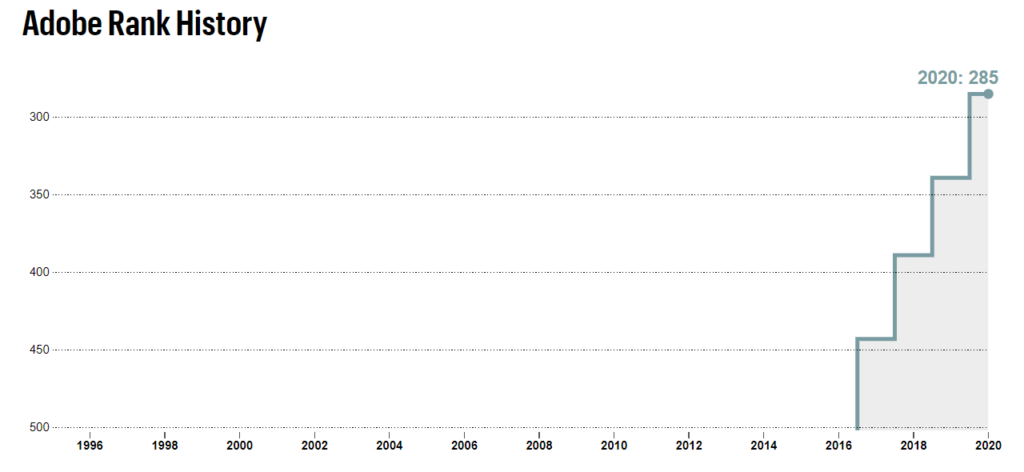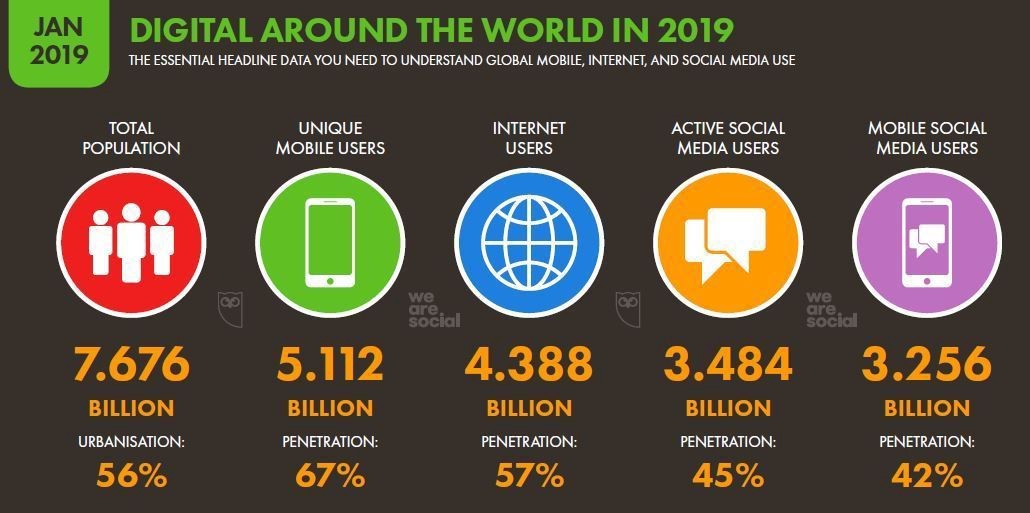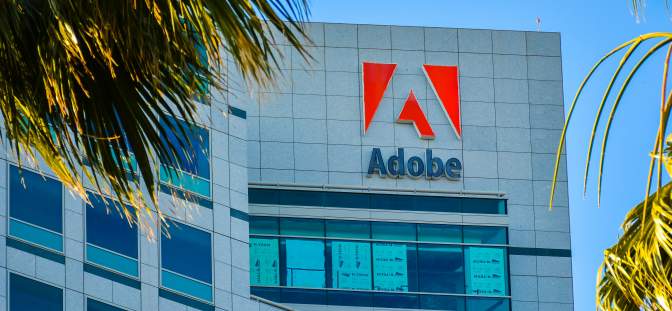Adobe is one of those rare companies whose product has become a verb. Adobe Systems Inc., like many other billion-dollar companies, was founded from the garage of John Warnock, one of the founders. The company is named after Adobe Creek, which is a 23-kilometer-long stream originating in the Santa Clara County, California, and it flowed behind Warnock’s home.
Currently, it has an excess of 22,635 employees, and its Net Income is US$ 2.95 billion, and its Revenue is US$ 11.17 billion, with operating costs of US$ 3.27 billion.

Growth Drivers (in India and the World)
One of the key drivers of growth for Adobe is the overall growth of Digital Marketing in India and around the world. Digital marketing is set to increase with improving disposable incomes and internet penetration across the globe. This will ensure that Adobe products are used continually, essentially making them perennial.
Thus, as Digital Marketing and other associated digital activities are on the rise and with decreasing attention spans on the internet, the need for creative digital tools is made necessary, which Adobe excels at. This ensures that Adobe products remain desirable year after year for generation after generation.


Product Divisions
Adobe has a wide variety of product lines that have enabled it to become the market leader it is today. The prudent thing to do would be to classify into clusters under which there will be multiple products. Adobe’s website does this by dividing their entire product category into four broad labels-
- Creativity and Design
- Marketing and Analytics
- PDF and e-Signatures
- Business Solutions
These four are further sub-divided into several different segments, and the complete product segmentation is given below-
- Creativity and Design
Design (Notable Products: Photoshop, Illustrator, InDesign, Aero, Adobe XD, Behance, Dimension, Dreamweaver, Dimension)
Photography (Notable Products: Lightroom, Photoshop Elements, Lightroom Classic, Creative Cloud for Desktop and Mobile, Stock)
Video and Audio (Notable Products: Premier Pro, Premier Rush, After Effects, Anywhere, Photoshop Camera)
Web and UX (Notable Products: Animate, Comp, InCopy, Adobe Spark, Spark Page, Spark Post)
- Marketing and Analytics
Advertising (Notable Products: Advertising Cloud, Experience Cloud, Media Optimizer and Dynamic Creative Optimization)
Analytics (Notable Products: Analytics, Analytics Cloud, Audience Manager, Experience Cloud)
Marketing (Notable Products: Campaign, Experience Manager, Primetime, Target)
- PDF and e-Signatures
Documents (Notable Product: Document Cloud)
E-Signatures (Notable Products: Acrobat Pro DC, Adobe Sign, Adobe Sign Mobile App, Fill and Sign)
PDF (Notable Products: Adobe Scan, Acrobat Pro 2020)
- Business Solution
Coldfusion (Notable Products: ColdFusion on AWS, ColdFusion Standard (2018))
e-Learning (Notable Product: Captivate)
Enterprise (Notable Products: Creative Cloud for Enterprise, Document Cloud for Enterprise)
Print Imaging (Notable Products: Design to Print, Adobe Embedded Print Engine, Adobe PDF Print Engine, Adobe PostScript)
Technical Communication (Notable Products: Technical Communication (2019), XML Documentation for Adobe Experience Manager)
Therefore, it is evident that Adobe has a massive stockpile of products that it uses to maintain its market dominance over its competitors. The four major areas that are mentioned above cover hundreds and thousands of businesses and individuals, and Adobe has successfully used that factor to market its products and successfully reap benefits from it.
Mergers and Acquisitions
Mergers and Acquisitions are essential for an organization not only from a growth point of view but a day to day as well as a future strategic context point of view. Adobe has, over the years, acquired companies big and small, it has also received companies that were themselves considered as giants.
Some of Adobe’s notable acquisitions are listed below:
| Name of Company | Acquired on | Acquired for (in US $) |
| Marketo | September 2018 | 4.75 Bn |
| Macromedia | December 20015 | 3.573 Bn |
| Omniture | September 2009 | 1.8 Bn |
| Magneto | May 2018 | 1.68 Bn |
| Fotolia | January 2015 | .8 Bn |
| Neolane | July 2013 | .6 Bn |
| Frame Technology | October 1995 | .57 Bn |
The quintessential and ubiquitous Adobe PDF that wee see and use around us has been made possible for several key acquisitions by Adobe over the years:
- OCR Systems (1992)- The technology by this company made it possible to manipulate the documents that were scanned into PDF
- Aldus Corp (1994)- This merger helped bring PDF to desktops
- Accelio Corp. (2002)- This company’s server-based technology is implemented in Adobe LifeCycle Design
- Macromedia Inc. (2005)- Many of Adobe’s PDF features like mobile PDF, media-rich PDFs or online collaboration would not have been possible without this company
Adobe added Behance to its creative cloud community, strengthening further its hold over the industry. By integrating Adobe Sign (EchoSign) into its ecosystem of products, the company ensured that one of the pain points- the inability to sign PDFs electronically – was addressed.
Marketing Strategy
Adobe uses a strong content marketing strategy to bolster its position in the industry. The result has been nothing short of spectacular for Adobe as in 2018; it crossed several key landmarks, the most impressive of them being exceeding market capitalization of a $ 100 Bn.
With its “always-on” marketing, Adobe constant reviews and analyses marketing data rather than spending crucial time to build the perfect marketing plan. This allows the company to change whatever is needed while on the go, thereby making it much more agile.
This policy has enabled the company to craft strategic marketing campaigns, fine-tune these strategies, and adopt best practices while on the go.
Factors that made Adobe Successful
It becomes vital to understand the reasons behind the success of Adobe as a company, and that can be best done by using a couple of tools that help in analyzing the company as a whole.
Competitor Analysis of Adobe
This section analyses the position of the company and where it stands along with its competitors. The problem with a company like Adobe (which is also its strength and competitive advantage) is the fact that no other competitor offers a diverse bouquet of products that are so uniquely related in a natural ecosystem as Adobe’s. Hence, to do a competitor analysis, different companies that belong to various sectors and segments need to be brought together.
SWOT Analysis of Adobe
Strengths
- One of Adobe’s key strengths was its ability to transition from a perpetual licensing system to a subscription-based licensing system. This led to an increase in their Annualized Recurring Revenue or ARR which will help provide the company with reliable cash flows in the future
- Adobe products are used and preferred all over the world, thereby adding to its brand equity. Its strong global presence can be rivaled only by a few of its competitors. Few of Adobe’s competitors have been able to consolidate a vast array of products under its portfolio as Adobe has
- Adobe distributes its offerings through a network of value-added resellers (VARs), original equipment manufacturers (OEMs), a detailed system of distributors and independent software vendors (ISVs)
- Adobe has an almost pure monopoly when it comes to designing, as Photoshop overshadows its competitors by miles. Similarly, Adobe caters to the film industry, the web development industry, and the video game industry, to name a few.
- The Adobe brand has been growing over the years and is now perceived to be a trusted one amongst designers and other users. It has steadily captured the market share by defeating all of its rivals.
Also Read: Philips – The Global Consumer Electronics Brand With Innovation At Heart
Weaknesses
- The primary weakness of Adobe is its high price that deters many potential customers due to which Adobe products are sold more in developed markets and less in emerging ones
- Poor customer service is also one of the critical weaknesses of Adobe
- Adobe’s weak presence in the video animation industry, especially in 3D modeling is also a potential weakness as it is just left out to competitors to grab
Opportunities
- With increase and growth in industries like Digital Marketing, PR, Branding, and a host of other sectors, Adobe still has plenty of room to grow and expand globally
- With increasing demand in cloud computing, and coupled that with the subscription model can lead to increased profitability for the company. Adobe Creative Cloud Desktop Apps are a set of Adobe Products that give the user control to a set of applications that have optional cloud services as well. Adobe needs to expand on this cue
- Adobe and Microsoft have entered into a strategic alliance wherein each company will help the other in transforming businesses globally by leveraging the latest developments. Adobe has chosen Microsoft’s cloud platform Azure as its preferred choice for its cloud offerings- Adobe Document, Creative, and Marketing clouds.
Threats
- The primary threat for Adobe is the threat of piracy due to the thriving torrent sites and peer to peer networks. This severely harms the company as it essentially is robbed of its revenue. This mostly happens in emerging markets like Russia, Africa, Pakistan, and India, to name a few.
- There are several substitutes of Adobe products that are either free or cost minimal to purchase. Some of the best Photoshop alternatives are- Luminar, GIMP, Pixlr, Paint.NET.
Conclusion
The picture below proves that Adobe’s very business model and the products it has been dealing with has suffered little to no consequences because of the global pandemic. Being mostly digital products, they can be facilitated over the internet, and the need for Digital Marketing and associated activities are always on the rise, thereby contributing to the company’s revenues even during a global viral pandemic.
To read more content like this, subscribe to our newsletter.


